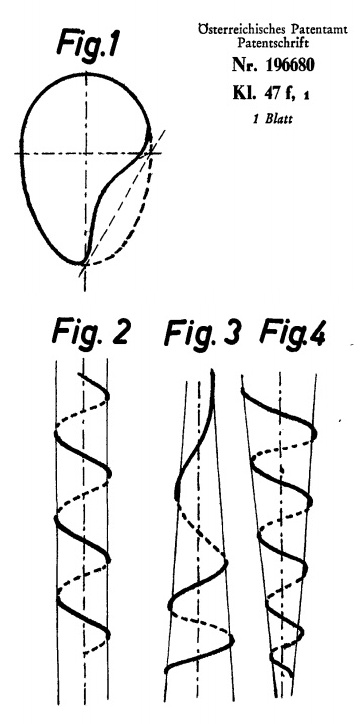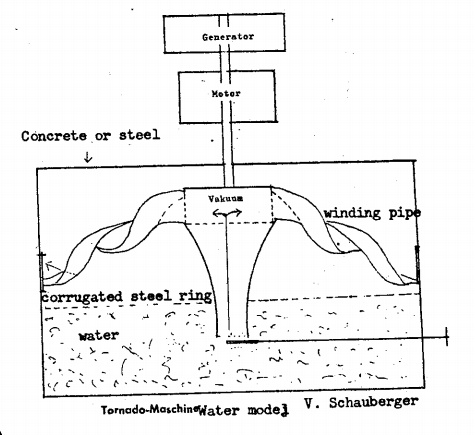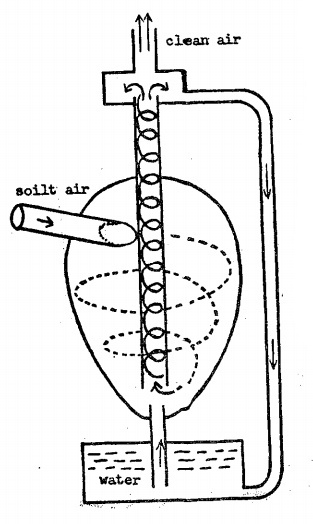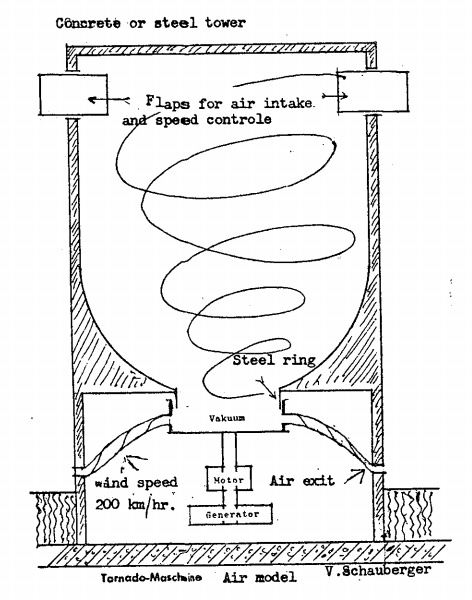The period that followed was difficult for him, that is until he discovered the Implosion Force. As happens to anyone harboring a new thought, no one understood him. He couldn't find a tradesman who would manufacture a spiral pipe with a dent in it. His criticism of fellow scientists caused him still more difficulties. He supported his theory with experiments but no one would listen as he was by then considered a dangerous outsider.
He was eventually found troublesome enough to warrant committing to an institution. He was, however. fortunate enough to have friends with influence and soon left, with a document in hand stating that he was in possession of all his faculties. He was henceforth the only one who could prove his sanity without the shadow of a doubt.
Early publication of Schauberger's invention resulted in [2] an invitation to work in America.
THE OIL COMPANY KISS OF DEATH
He came to Texas with his plans and models hoping to build a power plant for the home, which would make cheap electric power available. Unfortunately, the promises that had been made to him came to naught, and Schauberger, a very disillusioned man, became ill. He had consented under agreement to remain in Texas for three months. At the end of this period he was persuaded to sign the following contract before going home. Five days after landing in Europe, he died (1958).
(No wonder Schauberger's son wants nothing to do with America or Americans! This shabby treatment of the Austrian inventor proves that his Implosion motor was a threat to the established oil and nuclear power interests. So they murdered him with false promises, just as the Sick Industry broke the heart of Georges Lakhovsky in New York City in the early 1940s, with a research program on his Multi-Wave Oscillator which deliberately went nowhere!)
The Schauberger contract stated:
- that all of his patents would become the property of a consortium managed by a Mr. Donner
- that any future inventions or developments would also be owned by this consortium
- that he would refrain from discussing any of it with other parties
- that he would refrain from publishing
- that all plans and models would remain with the consortium
Like many inventors before him, Schauberger died poor, but his work and ideas are still alive. His son, Dip. Ing. Walter Schauberger, for one, is teaching about Schauberger's achievements in his Pythagoras-Kepler School.
Schauberger was a multi-faceted inventor. At the beginning of his career as a forest ranger he worked for a landowner whose young wife often went to the Riviera to play the casino at Monte Carlo. Always in need of money, her husband wanted to increase logging productivity. Oxen were then used to transport logs. This was slow and expensive. Schauberger suggested floating them down the creeks instead. He estimated the cost reduction at 90%. Engineers declared this was impossible since oak and beech are heavier than water and cannot float.
Schauberger knew his idea would work on cold winter nights if a spiral could be created in the flowing water, but that would have to be in a trough or flume with laths of larchwood nailed [3] diagonally to implode the flowing water. The heavy logs went forward like bullets shooting out of a rifle. They twisted about their own axis without ever bumping against the walls of the trough, even at full capacity.

THE SPIRAL MUST BE HARMONIOUS
The spiral is subject to bi-polarity. There are harmonious and inharmonious spirals, the same as with melodies. A spiral is harmonious when its radii are divisible by a whole number, i.e., 1 for the first coil, 1/2 in the second coil, 1/3 in the third coil, etc.
Nature uses egg shapes — one of its secrets. But it works slowly. Applying this principle would be inefficient in view of today's pollution and destruction. For this reason Schauberger wanted to speed up the natural processes. He observed that the planets orbit around the sun while at the same time spinning on their own axis. There is a double pattern as in waltzing. The spiral pipe incorporates this characteristic. It is conical and generally egg-shaped except for an inner bend along one quarter of its circumference. The shape causes the water to roll inward under the action of the rotor on which the pipes are mounted.
The manufacture of such a pipe was at first difficult; but a solution was eventually found: a sheet of copper was cut to the harmonious measure, bent in the shape of a pipe, welded along its length (embodying, of course, the irregular ovoid mentioned above). The impossible was made possible. We know that Nature uses the spiral in many ways: hurricanes, twisters, tornadoes, streams and ocean currents. The Tesla coil, for instance, seems to work through this principle, or perhaps works better because of it. When the last three inches of the secondary winding are tapered and conical, the [4] coil gives a better performance (e.g., the end where you attach the MWO antenna). If interested, you can obtain the conical ceramic insulators for this purpose ($3.50) from Information Unlimited, Amherst Professional Building, Box 716, Amherst, N.H., 03031. They carry transformers for Tesla coil 5000 Volt -- 16 M Amp ($18.00) and plans and kits for Tesla coils and high voltage capacitors as well.
VORTEX IN THE PYRAMID?
Schauberger introduced us to implosion and the centripetence force. Was he the first one to stumble upon this and put it to use? Chinese frugality is often chided by saying that anything that crawls in China eventually finds its way into the frying pan. Similarly, one could perhaps say that anything the Egyptians knew found its way into the Pyramids. Were the spiral and centripetence forces also incorporated into the Pyramids, beside the Pi, the Phi and all the other mathematical data which has been discovered therein?
Edward J. Kunkel, 295 W. Market St., Warren, Ohio 44481, says he has investigated almost every inch of the interior of the Great Pyramid. He suspected it was actually a giant ramp pump and that the pyramid was built by floating the blocks on barges on the rising water level in the interior of the Pyramid, as the name pyramid implies. In Greek, "pyr" means water, and "amid" means within. On page 30 of his self-published book, "The Pharaoh's Pump", Mr. Kunkel included a diagram of what is known as the well. He feels certain this was the air combustion chamber for the ram pump, which system would have included all the other passages as well. According to Mr. Kunkel the shape of the well had the following effect: Air trapped near the small ceiling formed a cushion, and the moment a downward flow occurred, air pressure in the cell conversely became extremely high and, seeking relief, moved the water between the cell and the chamber, thus initiating the action which a moment later developed into a whirlpool. A model worked better with this cell than without it. Was it knowledge or accident? Inspired by what he found in the Great Pyramid, Kunkel invented a ram pump and obtained a U.S. Patent on it.
ISKUSIN AND ISKADOR
Dr. Rudolf Steiner, M.D., the founder of Anthroposophie, found that the sap of both summer and winter mistletoe made a good remedy against cancer when injected. He called it Iskador. He described cancer as a disorder of the cell structure for which summer and winter mistletoe, when used together, could work wonders because of their regulating ability. Furthermore, during the process there is a build-up of a sort of electrical energy as the drops fall; this electrical energy, although a side effect, seems to be the main healing force. This energy [5] initially got lost during the mixing of the mistletoe as it was done by centrifuge. Dr. Med. Karl Koller, who was oriented to spiral force, reversed the process and used centripetal force which conserved the electrical property of the medicine. He called the drug Iskusin. (Electricity created by falling drops will be discussed later.)
THE WATER WHIRL IN PRACTICE
The pollution affecting the river Elbe in West Germany made it impossible for the city of Hamburg to use it as a source of drinking water. Deep wells had to be ‘drilled' and it was found that the water contains carbonic acid which is corrosive and endangered the City's water system. Carbonic acid can be neutralized with lime, at a ratio of 100 grams of lime to one cubic meter of water, or 6.6 tons of lime to 66,000 c.m. of water, to be mixed during a 24-hour period. Lime and water were mixed spirally by a mixer, the upper portion of which had a saucer-like shape with a diameter of 83" and was 23½" deep. A whirling arm of 3¼" diameter was driven by a motor. Not I only did the centripetal motion do all the mixing, but also reduced the need for lime by 50% in each well. The city uses six such mixers.
THE GOLDEN PLOUGH
Because of his experience with all kinds of water problems, Schauberger was nicknamed "water magician". He was once invited to Bulgaria in connection with the problem of farmland drying out. The Bulgarians were then using steam plows, the plough-shares being made of steel. Strangely enough, there was no drying out in the old Turkish settlements where wooden ploughs were still being used. Could the material used for the plough shares be the reason for the difference? Back home in Austria, Schauberger made experiments. His ploughshares were covered with copper plates. The result was surprising, up to 60% more harvest. New experiments show an increase of up to 100%.
The use of steel has disadvantages; it has no magnetic permeability. The earth magnetism gets cut and diverged. This creates turbulent energy fields, a chaos; but more important is the grinding off of tiny steel particles because of the fast working methods of today. The fine steel dust combines with the oxygen. The result is oxidation and rust, which not only deprive the soil of some of its oxygen — at the same time killing some of the micro-organisms in the soil — but also causes the groundwater to sink. In time the soil drys out. You can prove this by putting a small quantity of rust dust into water. This is sufficient to prevent falling drops from generating electricity.
Another experiment was used to put galvanic elements into [6] the ground. A copper plate was attached to one side of a container of water and a zinc plate to the other. This created an electric field, its radiation saturated the surrounding soil and the growth rate doubled.
BACK TO MESMER
It looks like we are back to Mesmer's experiment! If putting copper and zinc plates in water creates electricity that improves the growth rate of plants in that area, what would this do to men and women? It would be interesting to experiment in a bathtub. Leave the plates in some water for a day or two to create a build-up, then just add some hot water to fill the tub at the desired temperature. Perhaps some of the Associates would like to participate in this experiment and share their impressions with us?
A large technical company in Germany produces garden tools made from copper and byrillium, made after Schauberger's discovery. So far they are being used only in private homes and nurseries. Copper-byrillium tools are not as hard as steel; there is more deterioration; but this is helpful as it puts trace minerals back into the soil and creates bio-electricity without which there is little growth.
HOW IMPLOSION CAN IMPROVE YOUR SMILE
Orthodontist, Prof. Dr. Balters always disliked the orthodox methods used to straighten teeth and treat gum disorders. In his opinion, freeing the creativity and healing forces of the body is a much better solution. He consulted Schauberger in Linz, Austria to get an introduction to Implosion. Dr. Balters successfully developed the Bionator, braces made of caoutchouc which work from behind the teeth and assume the shape of the desired correction. The patient can remove the Bionator at will. It uses the implosion vacuum caused by the free flow of saliva and the suction of the gum.

THE WATER TORNADO IN ACTION
A motor turns the conical rotor in the middle of the tower. The pipes are mounted with the larger opening on the rotor. The smaller end, with the jet in it, reaches almost to the wall on which a wavy steel ring is positioned. When the rotor with the pipes turns, the centrifugal force presses the water out through the jets against the wavy or rippled steel ring, which causes a recoil and relieves the motor. The centrifugal force in the winding pipes creates a suction on the bottom part and so make an almost perpetual movement. The Air Model works the same way, only upside down.

The Schauberger Biotechnic Ltd, in Switzerland manufactures an air purifier. A ventilator blows the polluted air into [7] the egg-shaped housing. The Air rolls itself in and compressed at the bottom. Beneath the egg shape is a container with water, connected to the housing with a pipe. When the whirl is created, the water rises from the bottom through the pipe and mixes with the air, cleaning it. The clean air leaves through the top and the water flows back down depositing the dirt on the bottom.
FIRE IN THE WATER
"It is true that science has not yet solved the riddle of the waterjet, but Schauberger should not tell such fairy tales as that rolling pebbles in water disperse sparks which make the Rhine river glow at night. That makes it hard to take such a man seriously." Such remarks were often made when someone discussed Schauberger theories. Prof. Dr. Zimmerman heard it often and, when visiting Schauberger, talked about it.
Schauberger laughed, took two pebbles out of a drawer, filled a pail with common tap water and moved to a darker corner of the room. As he rolled the stones against one another in the water, Dr. Zimmerman could observe the flying sparks which had the same force as if it had been done in the air. Cold light: it was almost as in a fairy tale.
"Once in Yugoslavia it failed," [8] said Schauberger. "I had in mind to demonstrate this to a group of unbelievers, got the pebbles out of the river, but got no sparks. Then it dawned on me the stones had been on a long journey along the river bed and had lost their power. Take only pebbles from a mountain or the upper part of the river; better still, break the stones and use both halves."
Friction creates heat in the water as in the air. To create sparks, oxygen is needed and we find oxygen in water as well as in air. The legend about the glowing Rhine river may not be a fairy tale after all. When the strong river current pushed the rocks downstream, and the stones bumped against each other, then in the darkness of the night the dispersing of the sparks could be clearly seen (the water in those days was still clear and unspoiled). Today, after grading the river bed and its shores, the polluted water has lost its magic.
IS THE HOME POWER PLANT NEAR?
In different places in Austria and Germany, tests are being done with great enthusiasm on home power plant models. The greatest obstruction has been finding ways to construct the shape of the spiral pipes. This problem has now been solved with an accuracy and ease that were not possible in Schauberger's time. First, a wooden model was made. The profile of the outside will be the profile of the inside of the pipe. To achieve this, the wooden model has a two-piece form adjusted around it in some flexible material. After the material has hardened, the model will be taken out and wax poured in its place. The wax core will then have the shape of the wooden model and requires special handling.
First, it will be covered with a kind of epoxy or something similar in which powdered copper has been mixed. The second coat is made of layers of fibreglass tapes to reinforce it since it will be the wall of the pipe. Another coat of epoxy or other strong material finishes the product. After all coats have hardened a little heat makes the wax flow out and the spiral pipe is completed. And what is the status of power plants in America?
ONE MILLION WATTS WITH A TORNADO MACHINE
Victor Schauberger's friends have not forgotten the bad experience he had in the U.S. Since his plans and models remained here, they keep a watchful eye across the Big Pond for any news about related inventions. Special attention was given to a newspaper report about an American engineer who suggested using wind energy by creating a man-made whirlwind in a silo-like tower. Ing. James Yen, working for the Grumman Aerospace corporation, estimates that a turbine of only six feet in diameter could deliver two million watts. It would take a conventional turbine measuring 200 feet in diameter to produce the [9] same results. The silo-like tower is steady, has an open top and is open on one side. The wind enters the tower through the wing-like opening, starts a whirl and this, in turn, reduces the atmospheric pressure in the center. A vacuum is created, forcing air through the turbine. The sucked air makes it spin. Mr. Yen expects much from the comparably small turbine. Experiments in wind channels confirm his theory. He is confident that it would be possible to build whirlwind generators with a capacity of 100 and even 1000 megawatts. Let us hope the atomic age is over soon!

References
- Brandstatter, Leopold. Implosion Instead of Explosion. Vista, Calif.: BSRF. Print. [This xerographic brochure is included in an expanded re-edition: <#B0047, "IMPLOSION - The Secret of Viktor Schauberger">]
- Tubing for Flowing & Gaseous Media. (Osterreichisches Patentamt Patentschrift Nr. 196680). <http://rexresearch.com/schaub/at196680.pdf>
